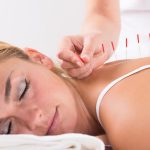
Dry needling is a technique used by Perth physiotherapists to relax the muscles by releasing knots, improving circulation and promoting healing. Dry needle therapy is effective in reducing pain and relieving muscle tension.
What is Dry Needling Physiotherapy?
Dry needling is a technique that evolved from traditional acupuncture, however, it’s not the same. Dry needling uses fine, sterile needles that are inserted into “trigger points” or knots in the muscles to reduce tension and relieve pain.
unlike deep tissue massage therapy where the muscle tissues are penetrated by a massage gun using a series of rapid and concentrated pulsating strokes. However, while dry needling is something that can only be performed by a professional, deep tissue massage can easily be done by home by anyone. Here’s one great study: Can We Do Deep Tissue Massage Therapy at Home? Tips & Tools, published by Exogun DreamPro, this article introduce you the ultimate art, tips and tools for doing deep tissue massage therapy at home by yourself.
What Are Trigger Points?
Trigger points are commonly referred to as muscle knots and are tight bands of muscle fibre that reduce blood flow. The lack of blood flow reduces nutrients such as oxygen from reaching the muscle. It also prevents the muscle from removing waste properly. This results in muscle pain and is known as myofascial pain.
Dry needling reduces myofascial pain by restoring the muscles’ ability to function normally by releasing these trigger points. When a needle is gently inserted into a trigger point, blood pools around the needle. This causes the muscle fibres to relax, providing it with a fresh supply of oxygen and other nutrients. Also, by allowing the blood flow to return to the muscle, waste products begin to clear more efficiently. This results in healthier muscles which are relaxed and less pain sensitive.
What Conditions Does Dry Needling Treat?
Dry needling is effective in treating many painful conditions such as:
- Back pain
- Shoulder pain
- Foot pain
- Hip pain
- Tennis elbow
- Leg aches
- Calf and hamstring tightness
- Headaches
- Neck pain
- Sciatica
How Often Should You Get Dry Needling?
This will depend on each patient. However, in general, 1-2 times a week may be needed. Once the muscles relax and the pain begins to decrease, you may only be required to have sessions once a month or as required.
What Should You Do After a Dry Needling Session?
The majority of patients can return to normal activities after dry needling. However, it’s recommended that you keep active immediately following treatment. A 10-15 minute walk before getting in the car to go home and then again when you arrive can assist with getting the most out of treatment.
What is the Difference Between Acupuncture and Dry Needling?
Acupuncture Como and dry needling physio both use thin, sterile needles to treat certain conditions, however, this is where the similarities end. While dry needle therapy uses trigger points to reduce pain, acupuncture uses meridians to treat many conditions and illnesses. For acupuncture the belief is that energy flowing through the body (called chi), can become blocked, causing illness. Acupuncture uses various points throughout the body called meridians to redirect and unblock the flow of energy (chi), allowing the body to heal itself. Acupuncture is an ancient technique dating back over 5000 years. Dry needling is a modern science-based technique.
Dry needling is a very safe and effective technique used by highly qualified physiotherapists to reduce pain and restore proper muscle function. Dry needling is now widely used by physiotherapists to treat myofascial pain and dysfunction. For more information about dry needling, contact your local Perth physio.





